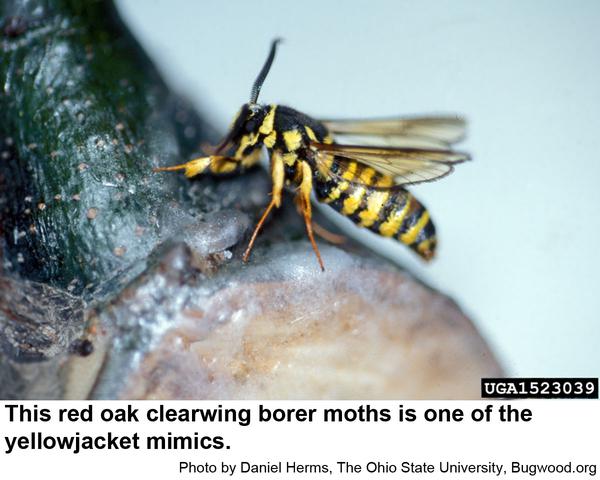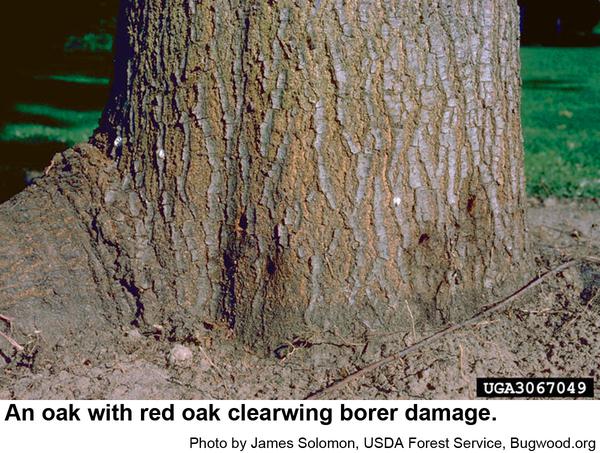Description and Biology
The red oak clearwing borer, Paranthrene simulans, is in the same family as the peach tree borer, lilac borer, dogwood borer and rhododendron borer. It is also called the oak clearwing. This borer tends to infest open grown, mature oaks in North Carolina. Adult moths emerge from April to June, and females lay eggs in bark crevices on the lower trunk. Newly-hatched, tiny caterpillars burrow in the inner bark and create ovoid chambers. As the borers grow, they extend their galleries. It takes two years for the borers to mature. In spring, after the second winter, larvae bore to the bark surface, close the gallery exits with a membrane, and then pupate. When mature, the pupae push through the membrane and finally in April through July of the second year, new red oak clearwing borer moths emerge. Some moths closely resemble the paper wasp, Polistes exclamans, whereas others closely resemble common yellowjackets (The moths are completely harmless to people.). After mating, the females lay eggs on the bark of susceptible trees to continue their wheel of existence.
Host Plants
Red oak clearwing borers infest American chestnut and red and white oaks. Nuttall oak, cherrybark oak, Shumard oak, and eastern black oaks are the principal hosts. In the Northeast, red oak clearwing borers cause most injury in nursery stock and sapling oaks. Bark swelling, pellet-like frass in bark cracks, and empty pupal cases on the trunk are visible signs of this borer. Tunneling promotes decay in the lower butt and causes losses to nursery tree production.
Residential Recommendations
Pheromone traps are available to monitor red oak clearwing borer moth flights in order to time pesticide applications. Probably the best method of control would be to apply a pyrethroid such as permethrin or some other pyrethroid in early May to prevent the new larvae from boring into the bark. When used as directed, pyrethroids are very toxic to insects but are not particularly hazardous to humans and pets (other than fish—avoid using pyrethroids around pools, ponds, and streams). Several pyrethroids are labeled for residential landscape use and are available in big box stores, nurseries, and plant centers. The active ingredient of any pesticide is listed on the front label usually in very small type near the bottom. The active ingredient of pyrethroid insecticides all end with "-thrin" such as bifenthrin, lambda-cyhalotrin, permethrin, etc. (Don't purchase resmethrin or pyrethrum as their residues do not last long once they are sprayed.) Even if a pyrethroid does not kill the red oak clearwing borer eggs, when the borers hatch they often eat the egg shell, so the poor thing may perish soon after hatching or after chewing through treated bark. Pyrethroids are also repellent to insects, so the moths are likely to avoid treated plants. Insect populations often fluctuate (sometimes dramatically) from year to year and place to place. To spray a pyrethroid is a gamble the following year the moths may not appear. On the other hand they could be more numerous. Only the lower trunk needs to be treated. Because the moths appear in mid to late spring, one application per year should give adequate control.
Other Resources
- Insects of Eastern forests. Drooz, A. T. editor. 1985. USDA Forest Service Misc. Publication 1426. 608 pp.
- Forest Pest Insects in North America: a Photographic Guide. Van Driesche, R. G. et al. 2012. UMass, Amherst, Univ. Georgia Center for Invasive Species and Ecosystem Health.
- Guide to Insect Borers in North American Broadleaf Trees and Shrubs. Solomon, J. D. 1995. USDA Forest Service Agriculture Handbook AH-706. 747 pp.
- Pheromone Traps for Insect Pest Management. Kowalsick, T., revisor. 2008. Hort. Diagnostic Lab., Cornell Univ. Coop. Ext. of Suffolk Co.
Red oak clearwing borer. Van Driesche, R. G. et al. 2012. Forest Pest Insects in North America: a Photographic Guide. - Extension Plant Pathology Publications and Factsheets
- Horticultural Science Publications
- North Carolina Agricultural Chemicals Manual
For assistance with a specific problem, contact your local N.C. Cooperative Extension Center.
This Factsheet has not been peer reviewed.
Publication date: June 16, 2020
Reviewed/Revised: April 1, 2025
Recommendations for the use of agricultural chemicals are included in this publication as a convenience to the reader. The use of brand names and any mention or listing of commercial products or services in this publication does not imply endorsement by NC State University or N.C. A&T State University nor discrimination against similar products or services not mentioned. Individuals who use agricultural chemicals are responsible for ensuring that the intended use complies with current regulations and conforms to the product label. Be sure to obtain current information about usage regulations and examine a current product label before applying any chemical. For assistance, contact your local N.C. Cooperative Extension county center.
N.C. Cooperative Extension prohibits discrimination and harassment regardless of age, color, disability, family and marital status, gender identity, national origin, political beliefs, race, religion, sex (including pregnancy), sexual orientation and veteran status.




